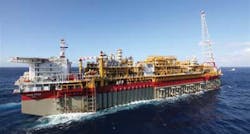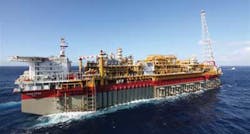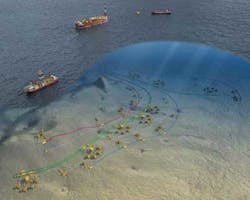Deepwater Usan FPSO development off Nigeria scores oil
Gene Kliewer
Technology Editor, Subsea & Seismic
Total, then operator of deepwater block OML 138 offshore Nigeria, started first production from Usan field in February 2012. Usan water depths range down to 850 m (2,788 ft). The development, 100 km (62 mi) offshore, consists of an FPSO initially to 42 development wells (23 producing and 19 water and gas injectors) connected by subsea flowlines.
At 320 m (1,050 ft) long by 61 m (200 ft) wide, the FPSOUsan is one of the largest in the world and can process 180,000 b/d of oil, 5 MMcm/d (176.6 MMcf/d) of gas, and store 2 MMbbl.
Total E&P Nigeria Ltd. sold its 20% interest in OML 138 to Sinopec earlier this month. Nigerian National Petroleum Corp. (NNPC) remains the concession holder. The other partners are Chevron Petroleum Nigeria Ltd. (30%), Esso E&P Nigeria (Offshore East) Ltd. (30%), and Nexen Petroleum Nigeria Ltd. (20%).
Hyundai Heavy Industries (HHI) won a $1.6-billion award from Elf Petroleum Nigeria to build the FPSO on a turnkey basis, from the engineering, procurement, and construction to the test runs. Construction began in 2008, the launch was in November 2010, and the vessel arrived at the field in July 2011.
HHI awarded Nexans a $9.4-million contract to manufacture and supply cables for the Usan field FPSO. Nexans' Kukdong factory in South Korea manufactured more than 1,700 km (1,056 mi) of power, control, instrumentation, and telecommunications cable for the project. Rated from 1 kV up to 30 kV, the low-voltage and medium-voltage power cables comply with the latest international standards. Nexans will also provide cables with different insulation types (ERP or XLPE) and armor protections (galvanized steel wire braid or copper wire braid).
Fugro GEOS has designed and commissioned an environmental and marine monitoring system for Usan. The real-time data are collected by sensors on a surface Wavescan buoy moored 2 km (1.2 mi) away, and by onboard instrumentation. The system acquires and processes data, which are distributed in real time via displays in both the radio room and the central control room onboard, and interfaced with the FPSO's distributed control system. Real-time information is needed for helicopter operations and to assist tanker movements, berthing, and general offshore operations. Data includes wind, temperature, humidity, pressure, cloud, visibility, precipitation, and vessel motion. Buoy sensors provide marine parameters such as waves, current, and sea temperature.
HHI contracted Sea Trucks Group to support the onsite installation with theJascon 30 DP-3 accommodation support vessel and associated services for 430 personnel. Jascon 30 had a new custom-built portable accommodation block installed on deck to provide extra accommodations for 184 persons. The team supported mooring, hook-up, commissioning, and startup of the FPSO.
HHI awarded Bardex Corp. a contract to design, manufacture, and supply a mooring system for the FPSO. The mooring system includes 16 BarLatch fairlead stoppers sized to hold the 1,770 metric ton (1,951 ton) break strength of the system's 147 mm (5 ¾ in.) R3 studless chain, four moveable linear chain jacks rated for a stall pull of 382 metric tons (421 tons), two 255 metric ton (281 ton) pull-in messenger winches, and two hydraulic power units each up to 480 kW.
Cameron supplied $650 million in subsea systems for Usan. The contract included subsea systems engineering and project management along with christmas trees, production and intervention control systems, manifolds, flowline connections, installation support and associated spares. The agreement also included an additional $2 million per well for installation and commissioning support over the life of the contract.
Cameron subcontracted to Acergy a $50- million contract to fabricate, assemble, and test eight manifolds and support structures, eight suction piles, 23 well jumpers, and other subsea structures. Work was done at Acergy's Globestar Yard in Warri, Nigeria.
A&P Group's ship repair yard in northeast England built two subsea arches for the Usan project. The mid-water arches, fabricated from steel and polymer materials, are buoyant support structures tethered to the seabed to support pipelines/risers transporting oil from the wellheads to the FPSO. A&P cut, shaped, welded, and assembled the 12 m (39 ft) high, 25 m (82 ft) long structures around large polymer buoyancy units.
Saipem contracted for the umbilicals, flowlines, risers, and oil loading terminal. EMC, a Saipem subsidiary, awarded Nexans a $54-million contract to develop, manufacture, and supply umbilicals and associated equipment. Nexans' specialist umbilical facility in Halden, Norway, produced 30 individual lengths of umbilical for delivery on 17 reels. The umbilicals supply control functions and chemicals for the field's subsea systems and connect the subsea wells to the FPSO.
The $1.3-billion contract required Saipem to assist in the commissioning and startup of the subsea umbilicals (72 km, or 44.75 mi), flowlines (61 km, or 38 mi) and risers, plus the oil-loading terminal, consisting of an offloading buoy and two offloading lines, and part of the FPSO anchoring system. Fabrication was in Nigeria, mainly in Saipem's Rumuolumeni yard. The offshore installation was by theSaipem FDS and Saipem 3000.
In February 2008, Total got approval from Nigeria to develop the Usan field. Proven and probable reserves of Usan were estimated to be in excess of 500 MMbbl of oil.
The Usan-1 discovery well was production tested at a restricted rate of 5,000 b/d of oil. This was followed by Usan-2, approximately 2 mi (3.2 km) west of the discovery on an up-dip portion of the fault block.


